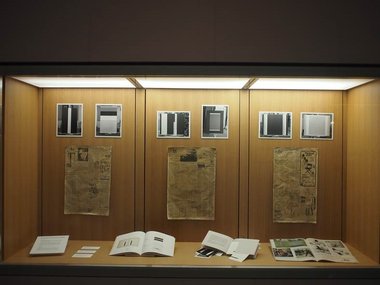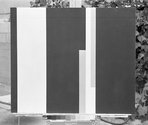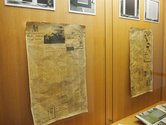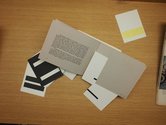John Hurrell – 11 October, 2016
So while we don't experience McLaughlin's artistry directly (none of his paintings are included), Connor's show instead examines art historical and sociological processes: the modernist documentation of innovation, the possible embedding of influential published opinions into the academic corpus of ‘acceptable' discussion, and the increasing awareness of new related content by the wider art audience. The dispersal of information and the acquiring of reputation.
Auckland
Fiona Connor (as curator)
John McLaughlin in Print
19 September - 16 October 2016
Donning her visored helmet and radiation-blocking, shiny space suit, and floating back through time, Fiona Connor in this AAG show takes us to a distant planet when art critics reviewed exhibitions in ink printed newspapers and the glossy pages of magazines, writing about artists like LA painter John McLaughlin (1898-1976) who had his first solo exhibition at the age of fifty-four. A minimalist painter much admired (and referenced) by Gordon Walters, McLaughlin’s nuanced works - from the late sixties and early seventies - are in this show mediated and recontextualised by six black and white, pre-cropped images of newspaper photographer Frank J. Thomas (taken outside in the artist’s garden), and the writings of local reviewers, Henry J. Seldis and Arthur Millier.
Mind you, the yellowing decaying newsprint from the mid-fifties (three digital copies of Los Angeles Times microfiches screened on to extremely thin coated foil) is very hard (if not impossible) to read, yet it is intriguingly mingled with local Californian advertisements, and placed above a mid-eighties international publication, Life magazine - its coloured illustrations include the artist posing with a painting on a golf course - along with a couple of elegant McLaughlin catalogues. All this in a large wall vitrine, positioned outside the entrance to the gallery’s E. H. McCormick Research Library.
Connor is fascinated by changing technologies and morphing community contexts, the continually evolving historical areas that those interested in ‘pure’ painting tend to deliberately ignore. She finds humour in the fact that despite the cropping out of various backyard details - such as a section of hose or portion of a concrete block wall - the final image on the newspaper page is surrounded by advertisements and various references to life in California. Even though local context is blocked by the front door it comes creeping in through the back.
There is also the fact that the shapes and colours (or tones) McLaughlin uses all have coincidental associations with aspects of nature or culture, despite the artist’s wishes to downplay them, to focus solely on perceptual or formal compositional properties as ‘meaning’ - albeit grasped at that time by a comparatively small coterie of ‘educated’ enthusiasts.
So while we don’t experience McLaughlin’s artistry directly (none of his paintings are included), Connor’s show instead examines art historical and sociological processes: the modernist documentation of innovation, the possible embedding of influential published opinions into the academic corpus of ‘acceptable’ discussion, and the increasing awareness of new related content by the wider art audience. The dispersal of information and the acquiring of reputation.
There is also the exhibition itself’s participation - as a variety of curated (or possibly readymade) artwork - within Connor’s own career strategy, and what Connor, as a much respected artist, provides for the institution, creating an absorbing display that links Los Angeles with New Zealand’s own art history (though not stated), local LA newspapers with McLaughlin catalogues (an acquired Auckland Library resource kept in the gallery); showing how one form of (local) discursive publishing enterprise eventually led to the (international) other.
A rivetting, astutely observant, underpublicised - but not to be overlooked - exhibition.
John Hurrell




 Two Rooms presents a program of residencies and projects
Two Rooms presents a program of residencies and projects Advertising in this column
Advertising in this column



This Discussion has 0 comments.
Comment
Participate
Register to Participate.
Sign in
Sign in to an existing account.